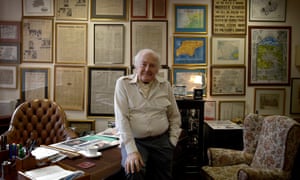
Sir Ray Tindle, founder of an eponymous newspaper group, is one of the great characters of our trade. I call him the grand old man of the local press.
Here is a man, now aged 91, who smiles through adversity, both personally and commercially.
Throat cancer some 20 years ago left him without a voicebox, but he continues to speak by covering a hole in his throat. If it is a strain, as it surely must be, he never shows it in public.
As owner of __more than 220 local titles across Britain, the Tindle group is one of the country’s top 10 newspaper publishers and has been responsible for launches and for rescuing papers unwanted by other outfits.
Although they have small circulations, and relatively small profit margins, he oversees a debt-free private business that is something to behold in these dark times.
He has faced the same tough challenges as his larger rivals. Sometimes it has caused certain titles to go into the red (while the group has remained profitable overall).
This time last year, he had to face the fact that the annual revenue decline had reached dramatic proportions, but Tindle - the epitome of the glass-half-full optimist - refused to give up the struggle. Instead he launched what he called his “fightback.”
What that amounted to was producing papers on reducing levels of newsroom staff, not by firing people (fair enough), but by the simple process of not replacing those who left.
This is not, of course, a fightback. In military terms, it is a rearguard action, a necessity forced on Tindle’s company by the decline in advertising revenue and in readers who are migrating to online news outlets.
Yet, according to Tindle in a chapter in a forthcoming book, Last words? How Can Journalism Survive the Decline of Print?,* the fightback by him and other publishers has received scarce publicity.
Sorry, Ray, but your claims to there being a fightback is nothing __more than spin, as are the arguments you advance throughout your chapter.
Example one: You write that “better newspapers are emerging” as the result of lessons learned and “a more viable, more effective press” is in the process of “arising.”
I don’t think any impartial observer of the state of local papers could possibly agree with that statement (as Sam Blackledge made clear in a piece published yesterday).
Example two: You write that local media are around “in great strength because they are doing a necessary, positive, effective job.”
But the reality, as highlighted by the request by publishers for the BBC to fund 150 reporters to carry out essential public service reporting, is the lack of effective coverage. Too many courts, inquests and council meetings go uncovered.
Example three: You write of “other forms of media” (meaning digital) that now exist and “will run alongside our newspapers but they will not supplant them.”
Really? How have you failed to note the 20-year decline in newsprint sales at all levels - local, regional and national - which is leading to the inevitable demise of papers?
Yes, newspapers have evolved and coped with the introduction of rado and television. But this is different. This is a revolution.
All that having been said, however, I am merely reciting the reality. My only issue with Tindle is over his refusal to recognise that reality. In so doing, he is blinding his staff and all journalists to the need to construct a viable strategy to save journalism.
If he, like other publishers, just goes on and on pruning staffs, the situation will get worse and worse.
He has not been nearly as ruthless as the larger groups, which must satisfy disinterested investors, but his being a nice chap has not made as great a difference as it might have.
What he needs to accept is that if we are to preserve, and hopefully enhance, local journalism then we must engage with the digital giants and, at the same time, embrace new business models. That’s the real fightback we need. Newspapers have no hope without it.
*Last words? How can journalism survive the decline of print? Edited by John Mair, Tor Clark, Neil Fowler, Raymond Snoddy and Richard Tait (to be published by Abramis Academic in January 2017)